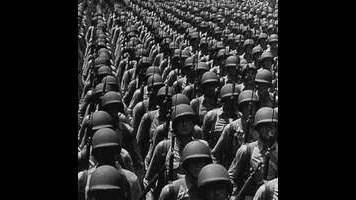Five Came Back traces the transformation of an artist to an instrument of war

In times of peril, some people feel compelled (or are, in fact, legally compelled) to pick up a weapon. There’s no shortage of guns and bombs in Five Came Back, writer Mark Harris and director Laurent Bouzereau‘s three-part wartime documentary, but the weapon in focus is of a very different sort. This is a series about the power of a camera, particularly when there’s an artist peering through the lens.
Adapted by Harris from his book of the same name, Five Came Back has its own cameras and lenses, of course. In the first episode, “The Mission Begins,” the series lays the groundwork for what’s to come, establishing the power of film to stir emotion (and to manipulate others) and underlining how connected moviegoing and current events were in the 1930s and ‘40s. To see a film was to melt into George Stevens’ Swing Time after viewing newsreels that covered Italy’s annexation of Ethiopia or the alliance formed between Hitler’s Germany and Imperial Japan. Bouzereau intercuts footage of nations preparing for or dealing with war with shots of people lining up to see the latest from Bette Davis, Fred Astaire, or Jimmy Stewart. Escapism and reality, all in one afternoon at the movies—that the two became even more linked should come as no surprise.
The people whose cameras were trained on the stars were all too aware of the world’s growing chaos, and “The Mission Begins” traces the actions and motivations of five award-winning filmmakers: John Ford, John Huston, William Wyler, George Stevens, and Frank Capra. Each found a way to contribute to the war effort, both before and after the United States became directly involved. Each had his own politics and sense of responsibility—some, like Capra, felt compelled by their own personal histories, while others, like Huston, were looking for adventure, or for a new mountain to climb. To help tell those stories, Harris and Bouzereau enlist another accomplished quintet, pairing each of their primary subjects with a contemporary artist. That’s where the star power of this series comes into play—well, these five and that narrator.
That’s not to say that Steven Spielberg, Lawrence Kasdan, Francis Ford Coppola, Paul Greengrass, and Guillermo Del Toro only dig into the lives and films of their designated artist (Spielberg and Wyler, Del Toro and Capra, Kasdan and Stevens, Coppola and Huston, and Greengrass and Ford), but the pairings do add resonance. In particular, listening to Greengrass, who began his career as a documentarian, talk about Ford’s camera positioning as he filmed the Battle of Midway is fascinating. “Ford always knew where to put the camera,” Greengrass laughs, and the included footage shows that to be true—footage achieved only because Ford put himself on a raised platform, which is perhaps not the safest place to be when enemy planes are zooming overhead.
While much of the first installment is dedicated to introducing these men and their early work, the most compelling stories arrive near the episode’s end. First is the aforementioned experience Ford had at Midway, as well as the tactics he used to get President Roosevelt to release his cut of The Battle of Midway, free of outside interference. The other belongs to Capra, who was tasked with using film to help transform an army of young, untrained people into fighting men who believed the was was worth fighting (and winning). Listening to both Del Toro and Capra himself detail the latter’s slow realization of how daunting this task might be and the means he must use to be successful is gripping stuff, offering a unique look both at an artists’ process and the ways in which one can turn an enemy’s seemingly lethal attacks into weapons.
Speaking of those attacks, there’s another filmmaker whose work looms large in “The Mission Begins”: Leni Riefenstahl. The inclusion of footage from Triumph of the Will helps to tell the story of these men in ways that not even the dulcet tones of Meryl Streep could manage. Riefenstahl’s hateful, masterful piece of propaganda shows the power of both the Nazi war machine and the artist who captured it. More importantly, it gives Ford, Huston, Wyler, Capra, and Stevens a specific enemy. Bullets will fly and bombs will detonate, but the biggest threat of all is the one to the mind. By simply including bits of Riefenstahl’s work, Five Came Back underlines its central point: a camera can be a terrifying tool.
Stray observations
- Welcome to Five Came Back coverage! Unlike the subjects of the film, this column will come back only twice more—at 1 p.m. EST, tomorrow and Monday.
- While I read (and loved) Mark Harris’s Pictures at a Revolution, I haven’t yet read Five Came Back. The series certainly bumped it up my list.
- “Oh, that I could have had a fight with Errol Flynn over Olivia de Havilland.”
- “You go ahead and go a thing, and after it’s all done, your knees start shaking.”
- “If he weren’t so evil, if there weren’t so many people getting killed… it was a comedy.”
- Did some of Mussolini’s more exuberant facial expressions look a little familiar to anyone else?
- This one’s for you, Frank Capra.